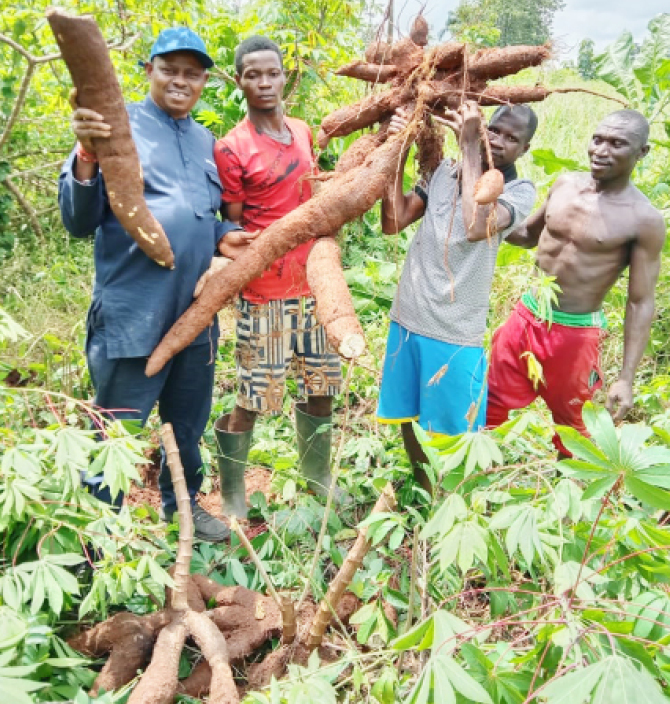What farmers must do to get good yields from cassava farms
Cassava farmers are battling to get better varieties of stems that can produce high yields amid absence of inputs from both the federal and state governments. The farmers face many challenges such as non-availability of land, poor land preparation, absence of mechanisation, lack of better inputs, funds, among others. But despite these challenges, cassava farmers […]

Imaghodo and his workers
Cassava farmers are battling to get better varieties of stems that can produce high yields amid absence of inputs from both the federal and state governments.
The farmers face many challenges such as non-availability of land, poor land preparation, absence of mechanisation, lack of better inputs, funds, among others.
But despite these challenges, cassava farmers in Edo State still have much to celebrate in terms of good yield, thereby making the state one of the highest cassava producing states in the country.
According to the state chairman, Cassava Growers and Garri Producers Association, Donatus Imaghodor, cassava farmers are still making waves in spite of the numerous challenges facing the production of the crop.
- Kogi assembly majority leader resigns in protest over terrorist tag
- Gov’ship results: APC petitions tribunals in Kano, Plateau, Rivers
“Generally, the challenges cassava farmers face in Edo State is non-availability of land, land preparation, incessant fire outbreak, lack of inputs and finance, among others.
“It is not easy for farmers to do the land preparation by themselves because they are not mechanised, not until we begin to mechanise the farmers and group them into clusters we would not make headway”.
He said Edo State is predominantly farmers and they are good in cassava farming but have been unable to get better yields because the farms are not mechanised.
He explained that it would be easier for cassava farmers if their farms are mechanised and the farmers put into clusters where they would be able to attract finance.
He said there has been no much problem in the aspect of inputs as the state has the stems in abundant, except this year when many farms were engulfed with fire.
“Following the development, there would be challenges in terms of getting stems for planting.
He said most farmers hardly get herbicides to control the weed in the farm as none is coming from the government.
“Though, once in a while, the Agricultural Development Program (ADP) does assist the farmers with inputs, which are usually not going round the farmers.
He said cassava farmers don’t really have security challenges, especially with herdsmen for some time now.
He said in the absence of mechanisation, cassava farmers are doing the farming in their own small way, adding that he is planning to cultivate 100 hectares at the moment.
How you can get good yields from your farms
According to him, any new person going into cassava production will have to first of all look at land availability and once he is able to acquire the land, he either do it manually or if he or has the financial capacity, he can go ahead with mechanisation.
“But if anybody wants to go into cassava farming on his own, it is easier, the person should look for a good land, prepare the land and get the stems for planting.
“You clear the land during the dry season and once the rainy season sets in, the farmer starts planting immediately after the land has been prepared”. You plant during the rainy season because before the dry season sets in, the cassava must have grown to be able to survive.
“In planting, the farmer has to give a space of one meter and that would ensure better yield for the farmer.
“If the land is well prepared, it would give better yield but if the land is not mechanised you hardly get better yield and you might not likely get 10 tons per hectare”
“But if the land is well prepared and mechanised with good agricultural practices, farmers can get between 25 and 28 tons per hectare. Getting good yield happens when best agricultural practice is adopted.
“After planting, you either use herbicide and pesticide to control the weed and embark on manual weeding. Weed control is important in order to get good yield,” he explained.
Imaghodor opined that for a better yield, farmers need to plant about 50 and 60 bundles of stem per hectare.
On the market for cassava in the state, Imaghodor said there was a huge market for cassava.
“We have a potential market across the state. Now, the state government has attracted investors around processing and they need cassava tuber to feed those factories.
He appealed to the state government to make Edo State a cassava hub, saying it would be beneficial to cassava growers in the state.
